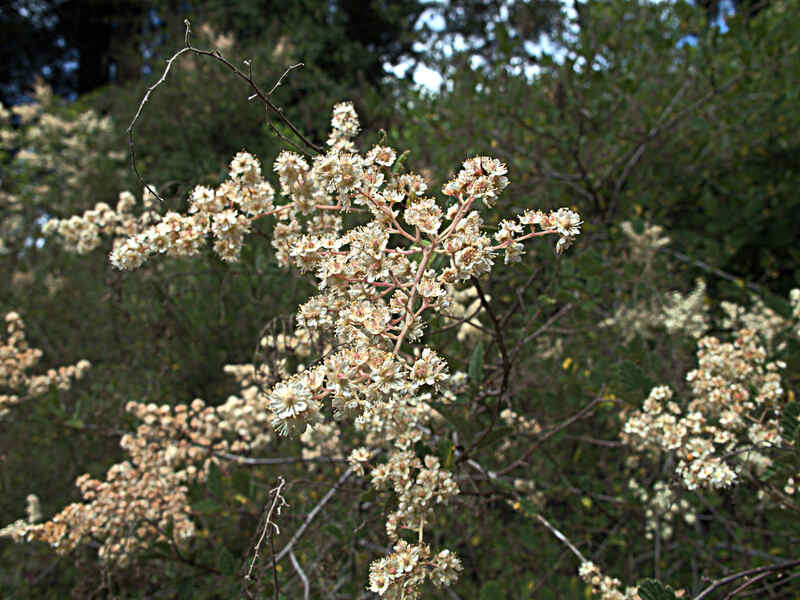10 Best Native Plants for Oregon
BY AUSTIN GEIGER | MAY 14TH, 2023 | LAWN CARE, OREGONNative plants are a beautiful low-maintenance option if you’re looking to introduce some new flora to your landscape. They’re also beneficial to your local ecosystem and the pollinators that call your area home. Picking out the right ones, however, can be a little tricky. Here are some of the best native plants for Oregon to help you choose your new backyard blooms.
In this article, we’ll discuss:
- 10 Native Plants for Your Oregon Landscape:
- How to Choose Native Oregon Plants
- FAQ About Native Plants
- Where to Find Native Plants in Oregon
10 Best Native Plants for Oregon
1. Oregon Grape (Mahonia aquifolium)
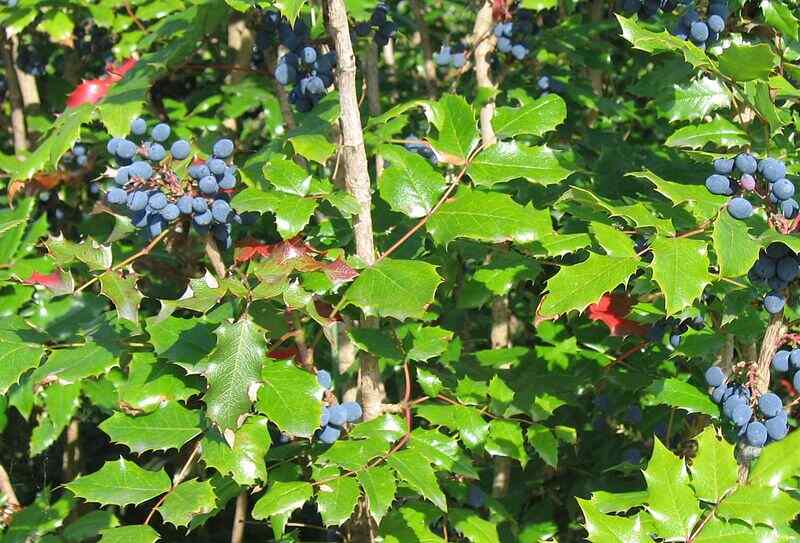
Photo Credit: Meggar / Wikimedia Commons / CC BY-SA 3.0
If you’re looking for a new plant for your Oregon landscape, there’s none better than the state flower. Oregon grape, also called holly-leaved barberry, is a low-maintenance and drought tolerant evergreen shrub with gorgeous yellow flowers that attract several varieties of pollinators such as honey bees and butterflies. It grows edible berries in the early fall, which are a good food source for local birds.
Oregon grape is a very hardy plant. It has reasonable water needs and can grow in just about any soil type. It prefers partial sun, so plant it in an area where the sun won’t be beating down on it 24/7, but don’t give it full shade, either. This plant makes a great hedge or ground cover as well as a nice addition to a pollinator garden.
Plant Type: Flowering Shrub
USDA Hardiness Zone: 5 to 8
Sun: Partial sun
Soil: All. Acidic or neutral pH; well-drained but moist soil
Duration: Evergreen
Fragrance: Honey
Bloom Time: Mid spring to winter
Water Needs: Moderate
Mature Height: 3 to 6 feet
Maintenance Needs: Low to moderate
2. Pacific Bleeding Heart (Dicentra formosa)
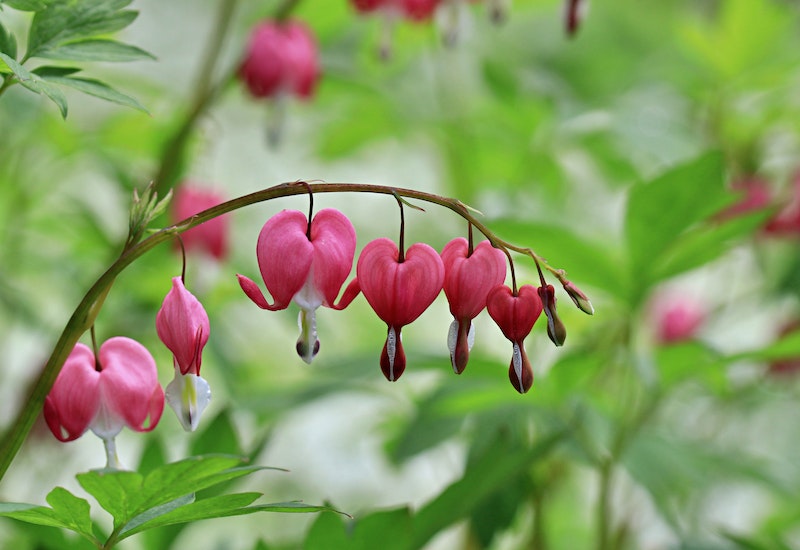
Photo Credit: Pexels
Pacific bleeding heart is an Oregon native wildflower, one with stunning bell-shaped pink flowers. This flower is low-maintenance and a great attractor for pollinators, butterflies and hummingbirds especially. It looks great in flower beds or containers and is a wonderful addition to a pollinator garden.
If you plant bleeding heart, keep in mind that all parts of it are mildly toxic. Touching it may irritate the skin, and if consumed in large amounts, it can do some harm. Make sure to keep pets and small children away from this flower.
Plant Type: Wildflower
USDA Hardiness Zone: 3 to 9
Sun: Partial sun
Soil: Clay, loam, or chalk. Acidic or neutral pH; well-drained but moist soil
Duration: Perennial
Fragrance: Floral
Bloom Time: Mid spring to mid summer
Water Needs: Moderate
Mature Height: 1 to 2 feet
Potential Hazards: Causes skin irritation on contact; poisonous if ingested in large quantities
Maintenance Needs: Low
3. Red Alder (Alnus rubra)
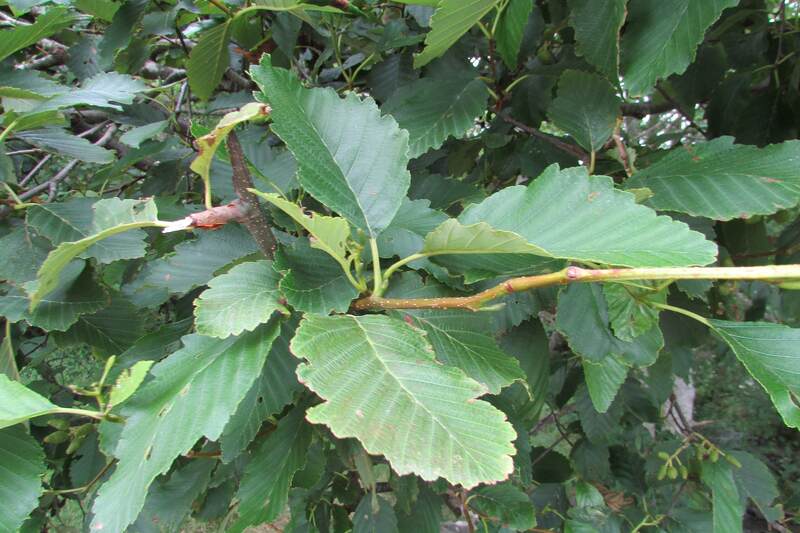
Photo Credit: Chris Light / Wikimedia Commons / CC BY-SA 4.0
Red alder is a deciduous broadleaf tree native to Oregon. It has lovely oval-shaped green foliage and grows cones similar to pinecones. This tree can grow up to a mighty 50 feet tall, making it a good centerpiece for your backyard, or can be planted at the edge to provide some shade. Red alder does well in just about any soil and is low-maintenance, even if its water needs are a bit high.
Plant Type: Tree
USDA Hardiness Zone: 5 to 10
Sun: Full sun to shade
Soil: All; well-drained but moist soil
Duration: Deciduous
Fragrance: None
Season of Interest: Year-round
Water Needs: Moderate to high
Mature Height: 40 to 50 feet
Potential Hazards: May irritate allergies
Maintenance Needs: Low
4. Red Flowering Currant (Ribes sanguineum)
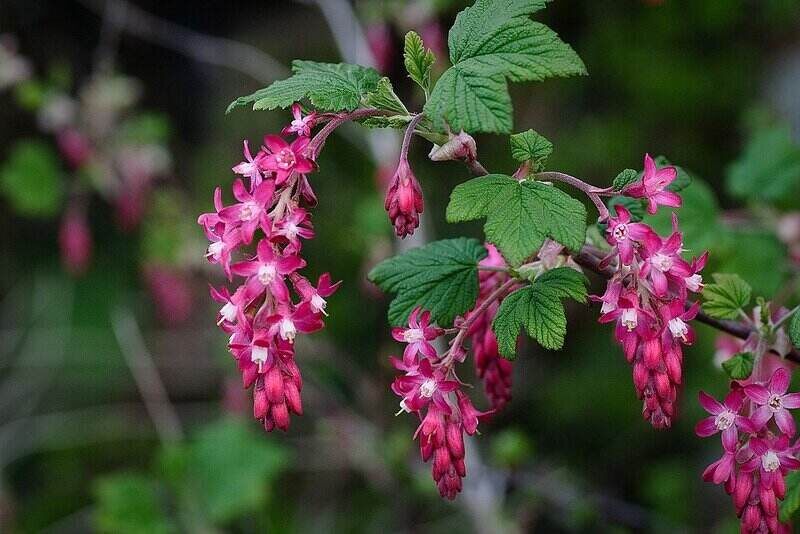
Photo Credit: Mark Robinson / Wikimedia Commons / CC BY 2.0
Red flowering currant is an Oregon native shrub with dark green leaves, beautiful tiny pink flowers that pollinators love, and edible berries that attract birds. It’s a low-maintenance plant that tolerates many different soil types, handles either full or partial sun, and has reasonable water needs. This currant is a great edging plant and makes a good addition to a wildlife or pollinator garden.
Plant Type: Flowering Shrub
USDA Hardiness Zone: 6 to 8
Sun: Full to partial sun
Soil: All; well-drained but moist soil
Duration: Deciduous
Fragrance: Sweet, rosemary
Bloom Time: Early spring to autumn
Water Needs: Moderate
Mature Height: 5 to 12 feet
Potential Hazards: None; the berries are edible
Maintenance Needs: Low
5. Nootka Rose (Rosa nutkana)
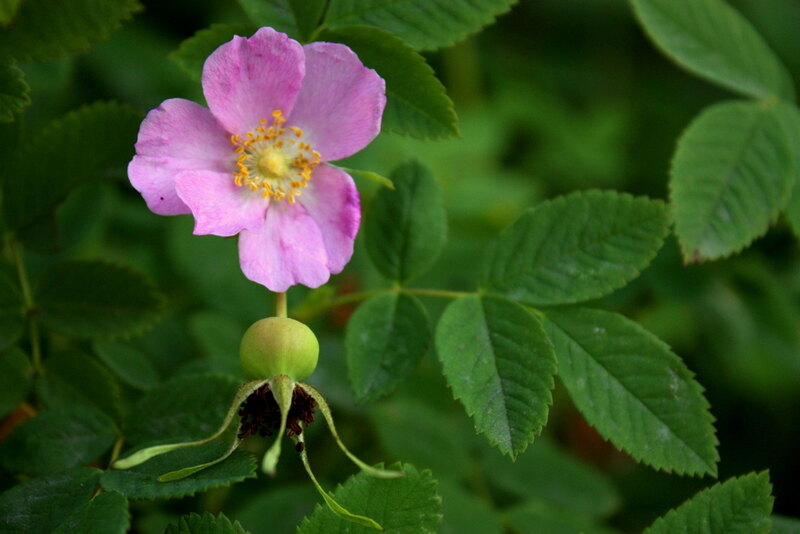
Photo Credit: Leslie Seaton / Wikimedia Commons / CC BY-2.0
Despite its name, Nootka rose is not a flower. It’s a deciduous shrub native to Oregon, one with beautiful bowl-shaped pink flowers that attract many different pollinators. It grows edible fruit called hips, which bring in local birds.
Nootka rose is a low-maintenance shrub with good water and sun needs, and it can handle many different soil types. It’s a great edging plant for your property border, though it tends to spread, so make sure it doesn’t take over. It’s a great choice for a pollinator or wildlife garden since many birds and small mammals like to nest in it.
Plant Type: Flowering Shrub
USDA Hardiness Zone: 5 to 9
Sun: Full to partial sun
Soil: All; well-drained but moist soil
Duration: Deciduous
Fragrance: Roses
Bloom Time: Late spring to autumn
Water Needs: Low to moderate
Mature Height: 5 to 6 feet
Potential Hazards: None; the fruit it grows is edible
Maintenance Needs: Low to moderate
6. Vine Maple (Acer circinatum)
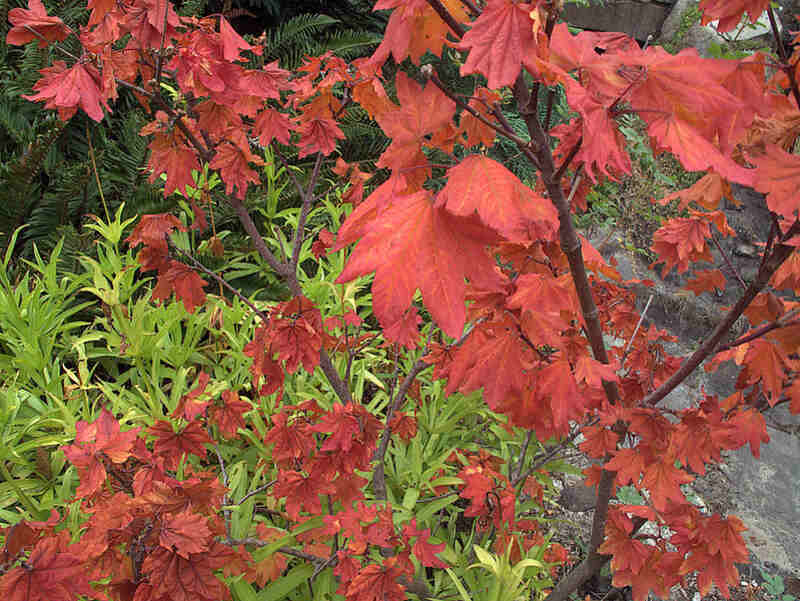
Photo Credit: John Rusk / Flickr / CC BY 2.0
Vine Maple is another Oregon native shrub, one that’s low-maintenance, has only moderate water needs, and handles either full or partial sun. It has nice green leaves that turn into stunning orange, red, and yellow in the fall. Vine Maple also has tiny purple and white flowers that give way to winged fruit, which attracts many different birds and small mammals.
If you want to use Vine Maple in your landscape, it may be best to use it as an ornamental plant. It’s quite a large shrub, and some specimens will grow tall enough to be considered small trees, so if you can get a big enough plant, you can also use it wherever you would a tree.
Plant Type: Flowering Shrub
USDA Hardiness Zone: 6-9
Sun: Full to partial sun
Soil: Clay or loam; well-drained but moist soil
Duration: Deciduous
Fragrance: Maple
Season of Interest: Mid spring to autumn
Water Needs: Moderate
Mature Height: 15 to 25 feet
Maintenance Needs: Low
7. Fawn Lily (Erythronium)
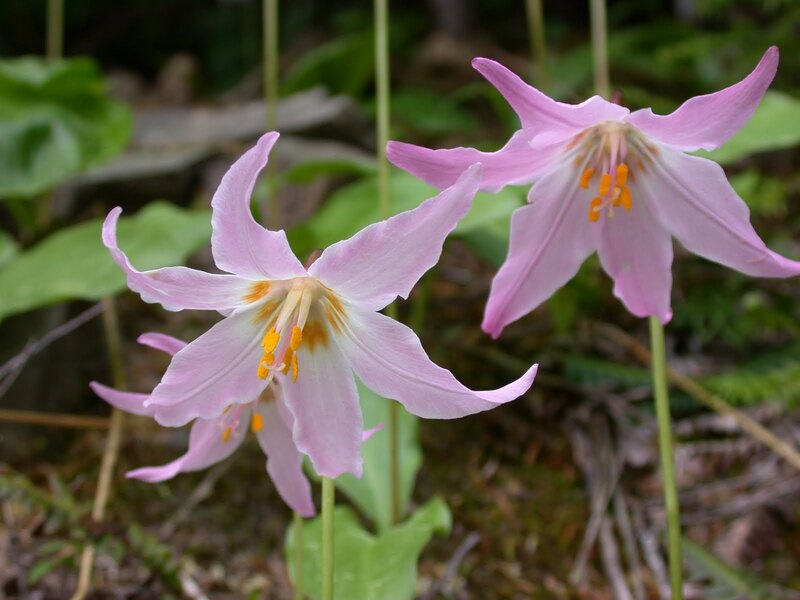
Fawn lily is an Oregon native wildflower with gorgeous upside-down yellow flowers. It’s low-maintenance, can grow in a wide variety of soil types, and likes partial sun. This flower attracts a multitude of different pollinators, including bees, moths, butterflies, and hummingbirds, which makes it a fantastic choice for a pollinator or wildlife garden.
Fawn lilies go great in flower beds and containers, and their small size makes them an especially good candidate for window boxes. If you plant them, remember that, like all lilies, they are deathly toxic to cats, so keep any feline friends you have out of the garden.
Plant Type: Wildflower
USDA Hardiness Zone: 3 to 9
Sun: Partial sun
Soil: All; well-drained but moist soil
Duration: Perennial
Fragrance: Floral
Bloom Time: Mid to late spring
Water Needs: Moderate
Mature Height: 8 inches to 1 foot
Potential Hazards: Toxic to cats
Maintenance Needs: Low
8. Oceanspray (Holodiscus discolor)
Oceanspray, also known as ironwood, is an Oregon native flowering shrub with gorgeous clusters of tiny white flowers that attract pollinators such as bees and butterflies. It’s low-maintenance, has low water needs, tolerates many different soil types, and handles either full or partial sun. If you want to use it in your landscape, it makes a good hedge or ornamental plant.
Plant Type: Flowering Shrub
USDA Hardiness Zone: 6 to 9
Sun: Full sun to shade
Soil: All; well-drained but moist soil
Duration: Deciduous
Fragrance: Floral
Bloom Time: Late spring to summer
Water Needs: Low to moderate
Mature Height: 3 to 20 feet
Potential Hazards: None; the fruit is edible
Maintenance Needs: Low
9. Pearly Everlasting (Anaphalis margaritacea)
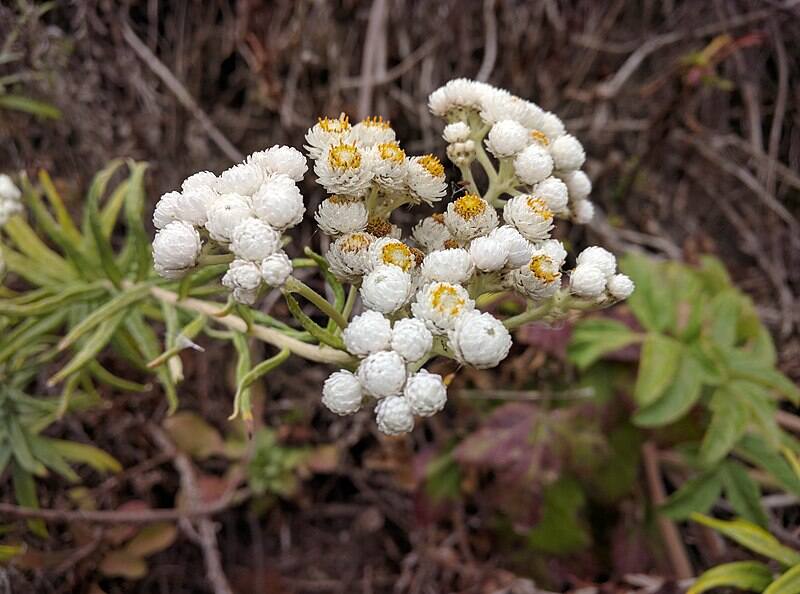
Photo Credit: Franco Folini / Wikimedia Commons / CC BY-SA 2.0
Pearly everlasting is a perennial wildflower native to Oregon. It grows clusters of tiny white flowers that are very attractive to pollinators. This plant is low-maintenance, can handle full or partial sun, and has good water needs. Pearly everlasting looks wonderful in flower beds or containers and goes great in a pollinator or wildlife garden.
Plant Type: Wildflower
USDA Hardiness Zone: 3 to 8
Sun: Full to partial sun
Soil: Chalk, loam, or sand; well-drained but moist soil
Duration: Perennial
Fragrance: Musky
Bloom Time: Mid summer to autumn
Water Needs: Low to moderate
Mature Height: 2 to 3 feet
Potential Hazards: None; this plant is edible
Maintenance Needs: Low
10. Oregon Sunshine (Eriophyllum lanatum)
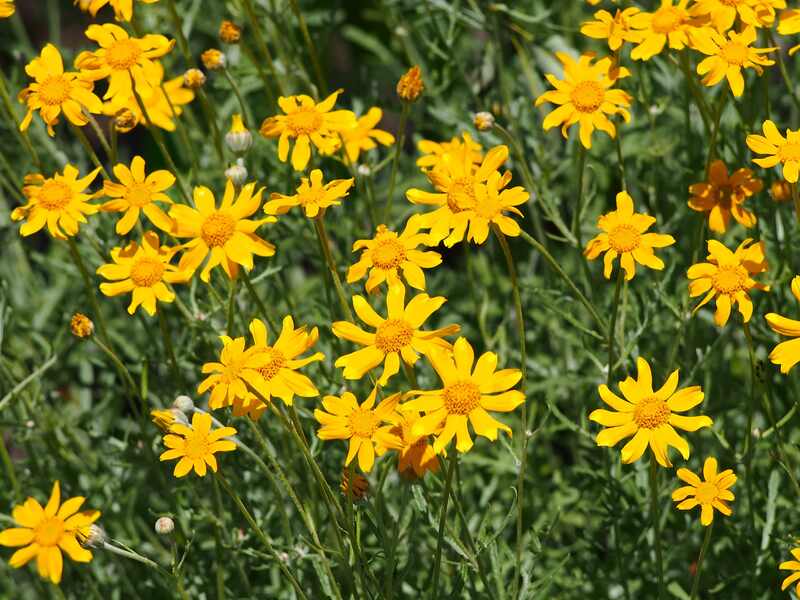
Photo Credit: Agnieszka Kwiecień, Nova / Wikimedia Commons / CC BY-SA 4.0
Also known as golden yarrow or woolly sunflower, Oregon sunshine is an Oregon native perennial wildflower. Its beautiful yellow flowers are very attractive to many different kinds of pollinators. It’s also a very hardy and low-maintenance plant that doesn’t need a lot of water and can handle either full or partial sun.
Oregon sunshine is a very versatile plant. This flower looks great in flower beds, containers, or window boxes. It’s a great choice for a pollinator garden, a xeriscaped landscape, or any area where you can’t get other plants to grow.
Plant Type: Wildflower
USDA Hardiness Zone: 5 to 8
Sun: Full to partial sun
Soil: Loam or sand; well-drained but moist soil
Duration: Perennial
Fragrance: Floral
Bloom Time/Season of Interest: Late spring to mid summer
Water Needs: Low
Mature Height: 1 to 2 feet
Maintenance Needs: Low
How to Choose Native Plants for Your Oregon Yard
When choosing new plants for your landscape, the first thing to consider is the environmental conditions it has to offer. If your yard is sunny, for example, you need to be careful not to get plants that do best in the shade. Take note of every condition that would affect your plants and look for ones that match them.
One of the most important aspects is the soil. Composition, pH, and drainage are important for a plant’s health. If you don’t know what kind of soil you have, find out and then look for plants that would grow well in it.
Another good criterion is Oregon’s USDA Hardiness Zone. The Hardiness Zones are used to measure the average minimum temperature in a certain area. Oregon is within zones 4b to 9b, which means that its average minimum temperature is between 30 degrees and negative 25 degrees Fahrenheit. Any plants native to it will likely fit this zone, but you should check anyway to avoid headaches down the road.
FAQ About Native Oregon Plants
All of the plants on this list are native to Northern, Southern, and Western Oregon. Only Oregon grape, Pacific bleeding heart, red alder, red flowering currant, and vine maple are not native to Eastern Oregon.
If given the right environmental conditions and nutrients, it’s entirely possible that native plants can start to take over your landscape and push others out. Thankfully, it’s a simple matter of making sure those plants don’t spread.
Some Oregon native plants to watch out for are red elderberry, mock orange, bitter cherry, and western sword fern.
If your landscape’s environmental conditions don’t match those of the plants you want, you can try to change them within reason. For example, if your landscape is too shady for your sun-loving Douglas fir, you can cut down some of the branches on other trees that are blocking the sun.
If it’s a small enough plant, you can also put it in a container where you can completely control all the conditions to help them thrive. You likely won’t be able to do this with trees such as dogwoods, madrones, or Oregon white oak, however, there are varieties of large plants and native trees, like Oregon crabapple, that are small enough to fit in pots.
Where to Find Native Plants in Oregon
If you’re looking for new native plants for your landscape, a good place to start is your local natural areas. Take a hike through natural parks, like Crater Lake National Park, Willamette Valley, or the Cascades, and take note of some of the native flora you see. To keep from upsetting a delicate ecosystem, however, do not take plants directly from the wild.
In order to ethically and safely obtain native plants, purchase from nurseries endorsed by the Native Plant Society of Oregon. They can help you find beautiful native plants such as manzanitas, serviceberry, columbines, and evergreen huckleberry.
If you need more general lawn care or landscaping help, contact a lawn care professional near you. We have trusted landscaping professionals in Portland and other cities throughout the state that can handle your outdoor needs.
Main Image Credit: Red-flowering currant / Peter Stevens / Flickr / CC BY 2.0
